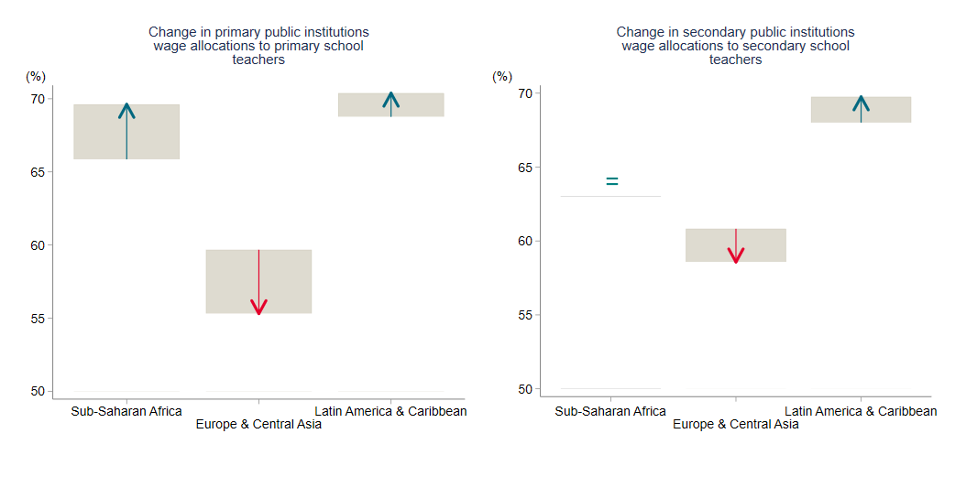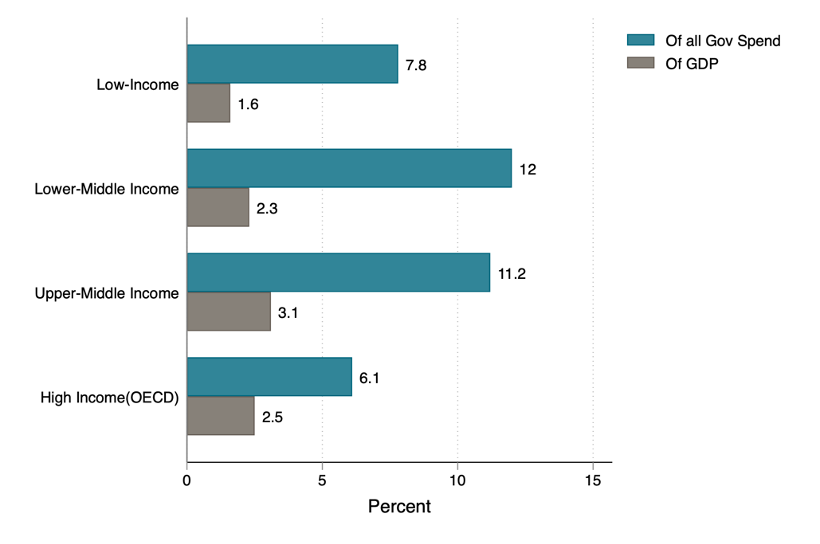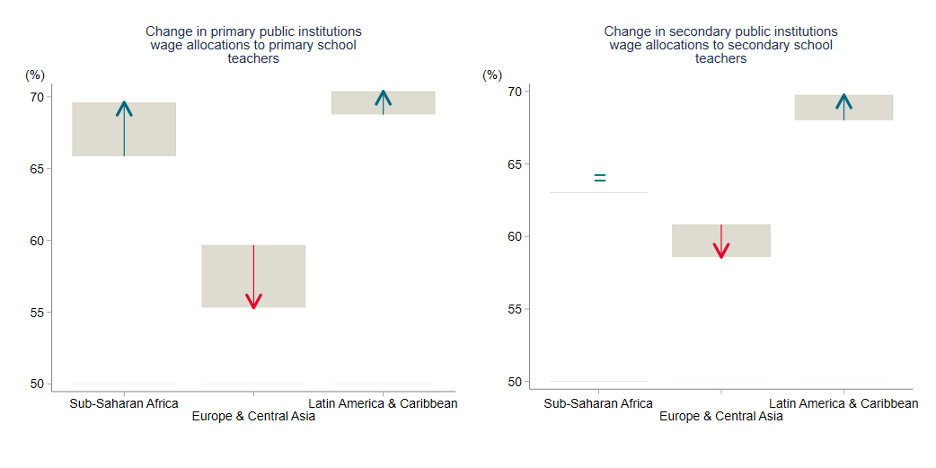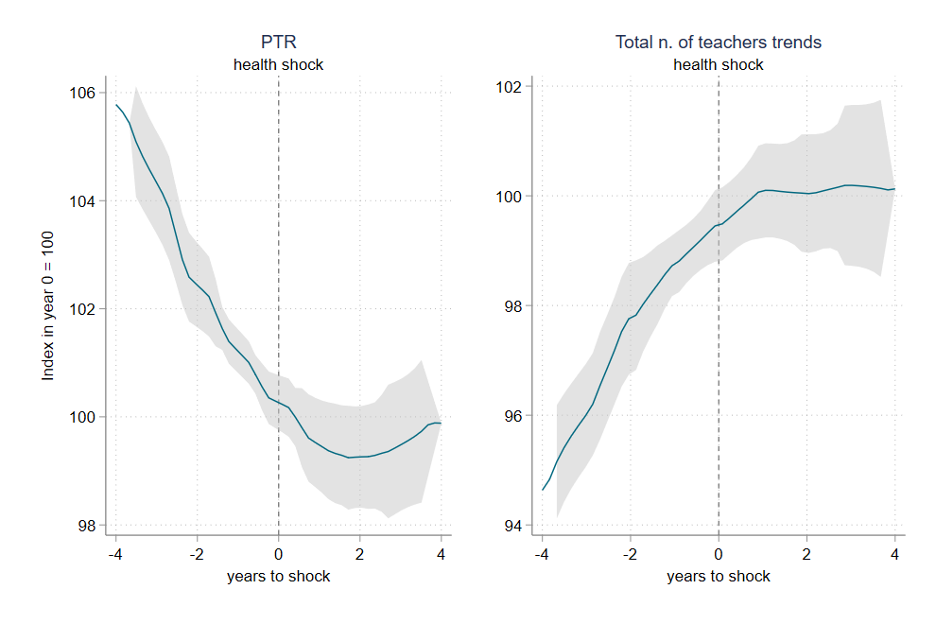Recommended

Blog Post
With developing countries in an economic crunch, education policymakers may be facing cuts to their budgets. In the first post of our education finance series, we outlined some of the ways in which the crisis may impact education finance. In part two of the series we’re examining the biggest-ticket item in most education budgets: teacher salaries.
Public sector wage bills (including teacher salaries) tend to be procyclical—they contract during recessions and expand during booms. But these average trends vary depending on the political environment, including the strength of public sector unions and the response of voters.
Here’s what we know so far about teacher salaries and teacher labor markets following economic and health shocks.
Past recessions have meant less salary spending in rich countries…
The Global Financial Crisis led to falls in funds for public K-12 education across the United States. In California public employment in schools declined more than other sectors, resulting in a loss of over 120,000 teaching positions. Shocks that reduce funding have had long-term effects on teacher churn by increasing layoffs, which can hurt student achievement, as the financial crisis and Hurricane Katrina shows. On the other hand, the Global Financial Crisis may have improved the quality of incoming teachers by narrowing the other options available to job-seekers, though this is not an ideal or sustainable way to improve teacher labor markets over the long-term. We have already begun to see budget cuts to public education and teacher salaries in the US as a result of the current crisis, including a recent call for a 20 percent reduction in teacher salaries by the Governor of Hawaii.
… but little change in poor countries
Cuts to teacher salaries following the pandemic could have consequences for teacher supply as well as for formal work opportunities more broadly. But if teacher salaries are protected at the expense of the rest of the education budget, tightening fiscal space may mean cuts in other critical areas. There are approximately 50 million teachers in developing countries and in many places teaching makes up a substantial portion of the formal labor market. Teacher salaries account for 10 percent of total public spending, and comprise an average of more than 70 percent of education spending—making questions about what happens to teacher salaries following a crisis important to consider.
Following the Global Financial Crisis, spending on teacher salaries dropped as a share of all education spending in Europe and Central Asia. By contrast, the share of spending on salaries went up in sub-Saharan Africa and Latin America. While the data on teacher pay are noisy, the figure below shows that teacher salaries can be protected through crises.
Figure 1. Spending down in Europe but up in Africa & Latin America and the Caribbean
Changes in teacher salary allocations following the Global Financial Crisis (as a share of total spending), 2006-2010
Source: Our analysis of UIS data
Note: averages consider two years before and after the crisis. Also includes 13 sub-Saharan African countries, 17 European and Central Asian countries, and 10 Latin American and Caribbean countries.
The upward trends in sub-Saharan Africa and Latin America could be driven by reductions in overall allocations to the education sector that protected teacher compensation over other areas of education spending. To examine this, in Figure 2 we show that the gaps between approved and executed funds (funds that were actually spent) were wider for non-salary budgets than for salary budgets following the Global Financial Crisis. This illustrates potential tradeoffs within the education sector in which protecting teacher salaries may put other components of the education budget at risk, including academic and enrichment programming, support for special education, learning materials, school meals, and more.
Figure 2. Salary spending comes before materials & buildings
Source: authors’ analysis of World Bank BOOST data
Note: Average of 17 countries. (Albania, Angola, Armenia, Benin, Brazil, Cameroon, Costa Rica, Fiji, Kenya, Mozambique, Niger, Namibia, Peru, Poland, Sao Tome and Principe, Togo, and Uganda)
Some countries have cut education wage bills, and salary delays are common
A recent UNESCO/UNICEF/World Bank survey found that the majority of countries made no changes to civil servant teacher salaries or benefits during COVID-related school closures. However, at least 75 countries globally have reported cuts to education wage bills, with low- and middle-income countries more likely to report cuts. These data are not disaggregated within the wage bill so it’s unclear if civil servant teacher salaries have decreased, or if these cuts are landing more harshly on contract teachers and other parts of the broader education workforce.
Even before the pandemic, salary delays for teachers were common in low- and middle-income countries. A global survey of teacher unions by Education International, an international NGO focused on supporting teacher unions, found that instances of salary delays and furloughs have been common following the crisis, and that teachers have been more likely to lose their livelihoods in low-income countries where households have been unable to pay school fees and where teachers have had more difficulty offering distance learning. It’s unclear from other sources how common this has been for civil servant teachers.
Civil servant teachers are only part of the teacher labor market. Private school and contract teachers are at a disproportionate risk of salary reduction and job loss
While public school teachers may be protected from significant wage reductions in many parts of the world, the structure of the teacher labor market also seems to play an important role in determining the impact shocks have on the education system as a whole. Budget cuts have to be made somewhere during a recession, and it’s unlikely that public education will be spared from these tough choices. Emerging evidence suggests that the broader education workforce, including contract teachers, may be disproportionately at risk. In the next post in this series, we explore how the pandemic is impacting contract teachers and private schools.
Adjustment comes through less hiring, not lower pay
If there are political constraints to reducing spending on existing teachers, one route to adjusting overall spending would be to hire fewer new teachers. This is roughly what our analysis shows has happened in past health crises, which, like the Global Financial Crisis, provide useful examples of how a shock affects education spending. In the figure below we show trends in the total number of teachers and in pupil teacher ratios before and after various health crises. Teacher recruitment levels grow steadily before crises and then flatten out. Gross enrolment levels remain roughly constant pre- and post- outbreak, leading to a halt in progress in reducing pupil-teacher ratios.
Figure 3. Teacher recruitment drops after a crisis
Trends in teacher recruitment pre-and post-crises
Source: Data on pupil-teacher ratios comes from World Bank, total number of teachers from UIS
Note: Countries and health shocks included in the analysis are as follows: Swine flu in France, Spain, UK, Poland, Portugal, Germany and Mexico in 2009; SARS in Hong Kong in 2003; Ebola outbreak in Guinea, Liberia, and Sierra Leone in 2014; MERS in Saudi Arabia and Korea in 2014 and 2015, respectively; Nepal and Pakistan earthquakes classified as WHO grade 2 and 3 emergencies in 2015 and 2013, respectively. We put data for each country on the same scale relative to the year of the outbreak, and then normalise to an index value so that year zero is equal to 100.
The World Bank/UNICEF/UNESCO analysis found that of the countries which have already announced education budget cuts, a majority have also stopped hiring teachers. In the immediate aftermath of the pandemic, small pupil-teacher ratios will be important for ensuring health, safety, and remediation. In the long-run, UNESCO estimates that an additional 70 million teachers will be needed to reach Sustainable Development Goal (SDG) 4. Hiring freezes and stagnated growth could slow school reopening and catch-up processes.
Teacher unions influence where cuts land
Within the education sector, teacher unions may try to shape the extent and nature of budget cuts and will likely try to protect teacher salaries—and union members—over and above other areas of education spending. For example, unions often set the rules in relation to staffing, layoffs, and compensation in public schools. During the Global Financial Crisis, junior teachers in the US were less likely to preemptively leave their schools in districts with collectively bargained policies allowing districts to consider additional factors outside of seniority in their layoff decisions. Places in the US with stronger teacher unions are less likely to open for in-person classes following union lobbying efforts. Globally, teacher unions in various countries have mobilized to protect teacher pay, support distance learning, and demand safe re-opening procedures. Education International recently launched a call urging the IMF to remove public sector wage caps from loan conditions.
Education budgets were more likely to be over-executed following the global financial crisis in countries with stronger unions, but not disproportionately in favor of teacher salaries
The graph below shows a simple analysis of the relationship between budget over-execution (spending more than the originally approved budget) and union strength. Wages were more likely to be over-executed than non-wage budget items in general, however we do not find a strong relationship between union strength and protecting wages over and above other areas of education spending across the sample. Rather, stronger unions increase the execution of non-wage budgets and don't disproportionately increase salary execution. Poorer countries with lower union density have greater over-execution for salaries and under-execution for everything else.
This could be because we are looking at overall union density and not specifically at the teacher unions. It could also be because teachers—even without strong overall unions—can sufficiently pressure governments to protect teacher salaries over and above other education budget items particularly in poor countries in which teachers make up a substantial share of the formal labor market. Alternatively, it’s also possible that places with strong unions have stronger wage contracts which are more difficult to negotiate in either direction following a shock.
Figure 4. Places with unions better execute non-salary budgets
Source: Author’s analysis of World Bank BOOST data and ILO union density
Note: Analysis of 13 countries with data between 2010-2016. Unbalanced dataset but all countries have at least two years of data. Countries include Armenia, Bulgaria, Cameroon, Costa Rica, Dominican Republic, Guatemala, Mauritius, Myanmar, Peru, Poland, Senegal, Tunisia, and Uruguay.
Despite often being some of the most vocal actors in the education space, teacher union priorities may not align with other stakeholders. For example, evidence from a public opinion survey in the US following the Global Financial Crisis found that citizens preferred for schools to cut teacher and administrator salaries, rather than funds for afterschool programs and instructional materials. These difficult tradeoffs, and potentially competing priorities, are important to consider as education budgets tighten globally.
Education policymakers need to find a balance
While it’s important to protect civil service teacher salaries and ensure that teachers stay in the education sector, policymakers and donors must also look holistically at the education budget following this prolonged crisis to ensure that other critical parts of the sector do not suffer disproportionately. With increased emergency costs related to maintaining health and safety, delivering distance learning, and implementing back-to-school and remediation programs, additional non-salary funds are needed in the education sector. Governments should weigh the tradeoffs of unequal cuts across budget items, prioritize efficiency, and engage in cross-sectoral finance efforts where possible. International donors and the private sector should work closely with governments to identify where there may be gaps in light of the salary and political constraints governments face, and prioritize filling those gaps in the most resource-constrained environments.
We are grateful to Susannah Hares and Maryam Akmal for helpful suggestions.
Disclaimer
CGD blog posts reflect the views of the authors, drawing on prior research and experience in their areas of expertise. CGD is a nonpartisan, independent organization and does not take institutional positions.










